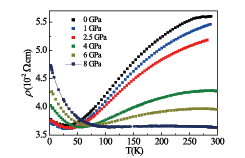High Pressure Electrical Resistivity Measurements for High-Tc Candidates Material Ln4Ni3O8 (Ln=La, Nd, Sm)
M. Uehara, I. Umehara, and Y. Uwatoko
Ln4Ni3O8 (Ln=La, Nd, Sm) contains NiO2 planes and its crystal structure is basically the same with high-Tc cuprate, and the formal valence of Ni is +1.33 composed of 3d9 and 3d8 mixed-valence state, being the same with high-Tc cuprate. Therefore, this compound seems to be a promising candidate for new high-Tc material. Despite these similarities with cuprate, this compound had showed neither metallic characteristic nor superconductivity [1-3], until we found that the intercalation and subsequent deintercalation treatment with sulfur (S-treatment) induced the metallic nature down to ~20 K (below ~20 K resistivity shows semiconducting upturn) in Nd3.5Sm0.5Ni3O8 [4, 5]. The sample without S-treatment is named to be the “as-synthesized sample” and the sample after S-treatment to be the “S-deintercalated samples” in this report. The as-synthesized and S-deintercalated samples are semiconducting and metallic (above ~20 K), respectively.

Fig. 1. Temperature dependence of electrical resistivity for the S-deintercalated sample of Nd3.5Sm0.5Ni3O8 under pressure.
Rietveld analyses based on synchrotron X-ray diffraction data at room temperature obtained in KEK suggest the removal of excess oxygens at apical site of Ni(2) which is in the outermost NiO2 plane by S-treatment [6]. Therefore, it can be inferred that the excess oxygens at apical site of Ni(2) impedes the metallic conduction and these are effectively removed by the S-treatment. The similar situation has been discussed on the role of reduction annealing necessary procedure to obtain superconductivity for T’-type high-Tc cuprate having a very similar structure to present system.
In order to see whether or not the semiconducting behavior at low-temperature is suppressed and the superconductivity emerges, electrical resistivity measurements at pressures up to 8 GPa were performed for metallic S-deintercalated sample, and the cubic anvil apparatus was used with a mixture of Fluorinert 70 and 77 as the pressure medium. The result is shown in Fig. 1. In the temperature range from 300 K to approximately 50–60 K, the electrical resistivity is decreased by applying pressure. However, below approximately 50–60 K, with increasing applied pressure, the electrical resistivity increases and the temperature where the electrical resistivity shows an upturn from metallic conductivity increases, displaying enhancement of the semiconducting nature. As the origin of this unexpected result it can be speculated as follows: the removal of excess apical oxygens by S-deintercalation is not perfect. The pressure pushes the remnant apical oxygens close to the NiO2 plane, and the effect of random potential increases, enhancing the tendency of localization. Similar pressure effect has been observed in T’-type high-Tc cuprate.
In conclusion, S-treatment removes additional apical oxygen but the removal is not perfect under the present S-treatment condition. Therefore, superconductivity might appear when additional apical oxygen is completely removed out.
References
- [1] V. V. Poltavets et al., Phys. Rev. Lett. 104, 206403 (2010).
- [2] Y. Sakurai et al., Physica C. 487, 27 (2013).
- [3] Y. Sakurai et al., JPS Conf. Proc. 1, 012086 (2014).
- [4] A. Nakata et al., Adv. Condens. Matter Phys. 2016, 5808029 (2016).
- [5] K. Kobayashi et al., JJAP Conf. Proc. 6, 011106 (2017).
- [6] M. Uehara et al., J. Phys. Soc. Jpn. 86, 114605 (2017)
